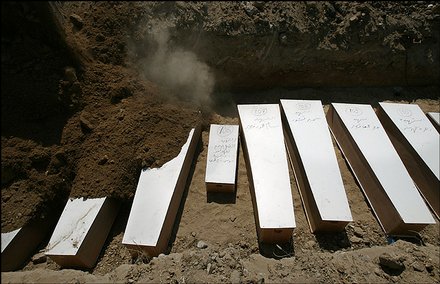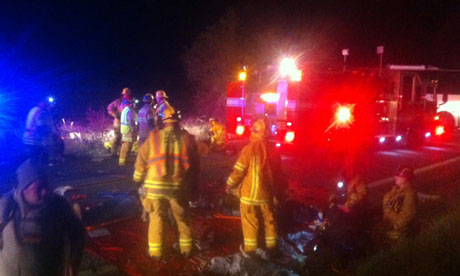
Britain's largest police force stole the identities of an estimated 80 dead children and issued fake passports in their names for use by undercover police officers.
The Metropolitan police secretly authorised the practice for covert officers infiltrating protest groups without consulting or informing the children's parents.
The details are revealed in an investigation by the Guardian, which has established how over three decades generations of police officers trawled through national birth and death records in search of suitable matches.
Undercover officers created aliases based on the details of the dead children and were issued with accompanying identity records such as driving licences and national insurance numbers. Some of the police officers spent up to 10 years pretending to be people who had died.
The Met said the practice was not "currently" authorised, but announced an investigation into "past arrangements for undercover identities used by SDS [Special Demonstration Squad] officers".
Keith Vaz, the chairman of parliament's home affairs select committee, said he was shocked at the "gruesome" practice. "It will only cause enormous distress to families who will discover what has happened concerning the identities of their dead children," he said. "This is absolutely shocking."
The technique of using dead children as aliases has remained classified intelligence for several decades, although it was fictionalised in Frederick Forsyth's novel The Day of the Jackal. As a result, police have internally nicknamed the process of searching for suitable identities as the "jackal run". One former undercover agent compared an operation on which he was deployed to the methods used by the Stasi.
Two undercover officers have provided a detailed account of how they and others used the identities of dead children. One, who adopted the fake persona of Pete Black while undercover in anti-racist groups, said he felt he was "stomping on the grave" of the four-year-old boy whose identity he used.
"A part of me was thinking about how I would feel if someone was taking the names and details of my dead son for something like this," he said. The Guardian has chosen not to identify Black by his real name.
The other officer, who adopted the identity of a child who died in a car crash, said he was conscious the parents would "still be grief-stricken". He spoke on the condition of anonymity and argued his actions could be justified because they were for the "greater good".
Both officers worked for a secretive unit called the Special Demonstration Squad (SDS), which was disbanded in 2008.
A third undercover police officer in the SDS who adopted the identity of a dead child can be named as John Dines, a sergeant. He adopted the identity of an eight-year-old boy named John Barker, who died in 1968 from leukaemia. The Met said in a statement: "We are not prepared to confirm nor deny the deployment of individuals on specific operations."
The force added: "A formal complaint has been received which is being investigated by the DPS [Directorate for Professional Standards] and we appreciate the concerns that have been raised. The DPS inquiry is taking place in conjunction with Operation Herne's investigation into the wider issue of past arrangements for undercover identities used by SDS officers. We can confirm that the practice referred to in the complaint is not something that would currently be authorised in the [Met police]."
There is a suggestion that the practice of using dead infant identities may have been stopped in the mid-1990s, when death records were digitised. However, the case being investigated by the Met relates to a suspected undercover police officer who may have used a dead child's identity in 2003.
The practice was introduced 40 years ago by police to lend credibility to the backstory of covert operatives spying on protesters, and to guard against the possibility that campaigners would discover their true identities.
Since then dozens of SDS officers, including those who posed as anti-capitalists, animal rights activists and violent far-right campaigners, have used the identities of dead children.
One document seen by the Guardian indicates that around 80 police officers used such identities between 1968 and 1994. The total number could be higher.
Black said he always felt guilty when celebrating the birthday of the four-year-old whose identity he took. He was particularly aware that somewhere the parents of the boy would be "thinking about their son and missing him". "I used to get this really odd feeling," he said.
To fully immerse himself in the adopted identity and appear convincing when speaking about his upbringing, Black visited the child's home town to familiarise himself with the surroundings.
Black, who was undercover in the 1990s, said his operation was "almost Stasi-like". He said SDS officers visited the house they were supposed to have been born in so they would have a memory of the building.
"It's those little details that really matter – the weird smell coming out of the drain that's been broken for years, the location of the corner Post Office, the number of the bus you get to go from one place to another," he said.
The second SDS officer said he believed the use of the harvested identities was for the "greater good". But he was also aware that the parents had not been consulted. "There were dilemmas that went through my head," he said.
The case of the third officer, John Dines, reveals the risks posed to families who were unaware that their children's identities were being used by undercover police.
During his covert deployment, Dines had a two-year relationship with a female activist before disappearing from her life. In an attempt to track down her disappeared boyfriend, the woman discovered the birth certificate of John Barker and tried to track down his family, unaware that she was actually searching for a dead child.
She said she was relieved that she never managed to find the parents of the dead boy. "It would have been horrendous," she said. "It would have completely freaked them out to have someone asking after a child who died 24 years earlier."
The disclosure about the use of the identities of dead children is likely to reignite the controversy over undercover police infiltration of protest groups. Fifteen separate inquiries have already been launched since 2011, when Mark Kennedy was unmasked as a police spy who had slept with several women, including one who was his girlfriend for six years.
On Tuesday the select committee will hear evidence from lawyers representing the 11 women who are suing the Met after forming "deeply personal" relationships with the spies. Kennedy, who worked for a sister unit to the SDS, is not believed to have used the identity of a dead child.
Vaz said MPs were now likely to demand answers from the Met police about the use of children's identities. "My disbelief at some of the tactics used [by undercover police] has become shock as a result of these latest revelations. It is clear that inappropriate action has been taken by undercover police in the past. But this has now taken it to a new level," he said.
"The committee will need to seek answers from the Metropolitan police, to find out why they allowed these gruesome practices to happen."
Monday 4 February 2013
http://www.guardian.co.uk/uk/2013/feb/03/police-spies-identities-dead-children








